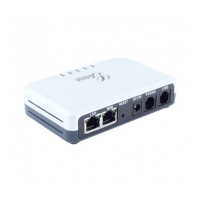After user makes a change to the configuration, press the “Update” button in the Configuration Menu. The
web browser will then display a message window to confirm saved changes, press “Apply” button to confirm.
Grandstream recommends reboot or power cycle the IP phone after saving changes
Rebooting from Remote
Press the “Reboot” button at the bottom of the configuration menu to reboot the phone remotely. The web
browser will then display a message window to confirm that reboot is underway. Wait 30 seconds to log in
again.
Configuration through a Central Server
Grandstream HT503 can be automatically configured from a central provisioning system.
When HT503 boots up, it will send TFTP or HTTP/HTTPS requests to download configuration files
“cfg000b82xxxxxx” and “cfg00082xxxxxx.xml”, where “000b82xxxxxx” is the LAN MAC address of the
HT503. If the download of “cfgxxxxxxxxxxxx.xml” is not successful, the provision program will issue request
a generic configuration file “cfg.xml”. Configuration file name should be in lower case letters.
The configuration data can be downloaded via TFTP or HTTP/HTTPS from the central server. A service
provider or an enterprise with large deployment of HT503 can easily manage the configuration and service
provisioning of individual devices remotely from a central server.
Grandstream provides a central provisioning system GAPS (Grandstream Automated Provisioning System)
to support automated configuration of Grandstream devices. GAPS uses enhanced (NAT friendly) TFTP
or HTTP (thus no NAT issues) and other communication protocols to communicate with each individual
Grandstream device for firmware upgrade, remote reboot, etc.
Grandstream provides GAPS service to VoIP service providers. Use GAPS for either simple redirection
or with certain special provisioning settings. At boot-up, Grandstream devices by default point to
Grandstream provisioning server GAPS, based on the unique MAC address of each device, GAPS
provision the devices with redirection settings so that they will be redirected to customer’s TFTP or
HTTP/HTTPS server for further provisioning.

